Ditching the plastic food storage containers is one of the easiest ways to decrease exposure to things like toxic phthalates and BPA (and other bisphenols).
In this article, we’re going to talk about why that is, and then we’ll give you our picks for the best non-toxic and plastic-free food storage containers to used instead.
Related Articles:
- Non-Toxic Lunch Boxes & Bags
- The Best Options for Non-Toxic & Reusable Ziploc Bag Alternatives
- Non-Toxic & Plastic-Free Disposable Dinnerware
- Are Melamine Dishes Toxic?
Table of Contents
- Our Top Picks at a Glance: Non-Toxic & Plastic-Free Food Storage Containers in 2023
- Why Should You Skip the Plastic Food Storage Containers?
- Safer Materials for Food Storage
- Other Things to Consider When Choosing the Best Non-Plastic Food Storage For You
- 1. Glass Food Storage Containers
- 2. Stainless Steel
- 3. Silicone
- 4. Beeswax Wraps
- 5. Veggie-Saver Bags
- Other Materials to Consider for Non-Toxic Food Storage
- Best Practices If Using Plastic Food Containers
- What Should You Do With Your Old Plastic Food Storage Containers?
- Final Thoughts on Plastic-Free & Non-Toxic Food Storage Containers
Featured Image Credit: Pyrex/Crate & Barrel
This article contains affiliate links, which means we may earn a commission if you decide to make a purchase.
Our Top Picks at a Glance: Non-Toxic & Plastic-Free Food Storage Containers in 2023
- Best Glass Food Storage Containers: Pyrex, Anchor Hocking, & OXO
- Best Stainless Steel Food Containers: ECOlunchbox
- Best Non-Toxic Plastic-Wrap Alternative: Beeswax Wraps
- Best for Storing Produce in the Fridge: Vejibag Organic Produce Bags
Why Should You Skip the Plastic Food Storage Containers?
The two main concerns when it comes to food storage involves phthalates and bisphenols. Bisphenols (like BPA and BPS) are more likely to be found in harder plastics (such as Tupperware containers), while phthalates are more likely to be in softer plastics (like Ziploc baggies).
Both of these categories of chemicals are known endocrine disruptors, which means they can disrupt proper hormonal function and ultimately lead to a range of health concerns, from infertility to cancer and more. In part because of the fact that the hormonal processes of the body are so sensitive, most of these chemicals can cause problems even in very small amounts.
Some scientists call these toxicants “hit-and-run” chemicals, meaning they can do quite a bit of damage in a small amount of time.
Phthalates and bisphenols actually have a relatively short half-life, which means our bodies can naturally detox them pretty quickly (especially compared to other toxicants like PFAS, which are nicknamed “forever chemicals” because they stick around for decades).
However, they can really mess things up in the short amount of time they’re in our system.
When you store your leftovers in plastic containers, these chemicals can leach into your food, and then you ingest them. Although leaching can happen under any conditions, certain things speed it up. For example, heating plastic or storing certain types of foods (acidic or high-fat foods) can increase the overall amount of toxicants that make their way into your food.
Be Careful of “BPA-Free” Plastic Food Containers
You’ll see a lot of plastic food storage containers that have “BPA-free” labels on them, but this doesn’t automatically mean they’re non-toxic.
When the public became aware of the potential negative health effects of BPA, companies started taking it out of their products… But they often just replaced it with other types of bisphenols like BPS and BPF. This allows them to advertise their products as “BPA-free” while not actually addressing the toxicant issue.
The problem is that BPA “sister chemicals” like BPS and BPF are not any better than BPA… In fact, they may even be worse. You can read more about this here.
Safer Materials for Food Storage
So, which plastic-free food storage containers are not harmful to people’s health? The primary non-toxic and plastic-free food storage materials we recommend are:
- Glass
- Stainless Steel
- Silicone
- Beeswax (wraps)
- Organic Cotton (bags)
Each of these materials comes with pros and cons, so we’re going to go through each of them and give you some of the brands we recommend.
Other Things to Consider When Choosing the Best Non-Plastic Food Storage For You
Material safety isn’t the only thing to consider when picking out your food storage containers—they need to be practical and fit well into your lifestyle as well!
Here are some more things to consider when choosing the best non-toxic food storage containers for you and your family:
Is it for kids, adults, or both?
Who is going to be using the storage containers, and in what capacity? You may want to get some glass storage containers to use at home, but silicone baggies for the kids to take to school.
Similarly, will you be storing/transporting liquids or solids? If you’re packing liquids in your lunch, you’ll probably want to choose a leak-proof option to prevent spills.
How much space do you have?
Consider the storage space you have in your kitchen cabinets, as well as the space you have in your lunch box or backpack. Do you need something that can fold up or squeeze into small cabinets? Then you might want to go with silicone Stasher bags. Do you need something that can stack or nest inside each other? If so, you might go with glass containers.
Will your food need to be reheated?
All of the materials and brands listed below are safe and easy to use for cold or room-temperature food. But glass is usually the best option if your food needs to be microwaved. (Just be sure to remove the lid first if it contains plastic.)
Stainless steel can be put in the oven, but it’s not microwave safe.
Silicone is iffy… Some research suggests that it can leach endocrine disruptors at temperatures over 300° (the microwave doesn’t usually get that hot). So I would say that silicone is definitely safer than plastic in the microwave, but if you want to be precautionary, you may want to try and keep silicone away from the heat when possible.
Also, if your glass will be going through rapid temperature changes (like from the freezer to the oven), make sure you go with borosilicate glass.
Now, let’s get on with our recommendations for materials and brands!
1. Glass Food Storage Containers
Some of the best plastic-free food storage containers are made from glass. Here are the pros and cons…
PROS
- Can last a really long time when taken care of
- Does not leach bisphenols, plasticizers, heavy metals, etc.
- Generally microwave safe, dishwasher safe, oven safe, and fridge/freezer safe
- Easy to clean
- Doesn’t stain (so it won’t turn orange after storing your pasta sauce!)
- Recyclable
- See-through — it’s easy to see your leftovers!
CONS
- Breakable (May not be the best choice for those with kids unless it has a silicone covering. Some schools don’t allow glassware.)
- Heavy
- Not all lids that come with glass storage containers are completely plastic-free
Glass containers are pretty easy to find and there are a lot of sizes, shapes, and colors available. Here are a few brands I like:
Pyrex
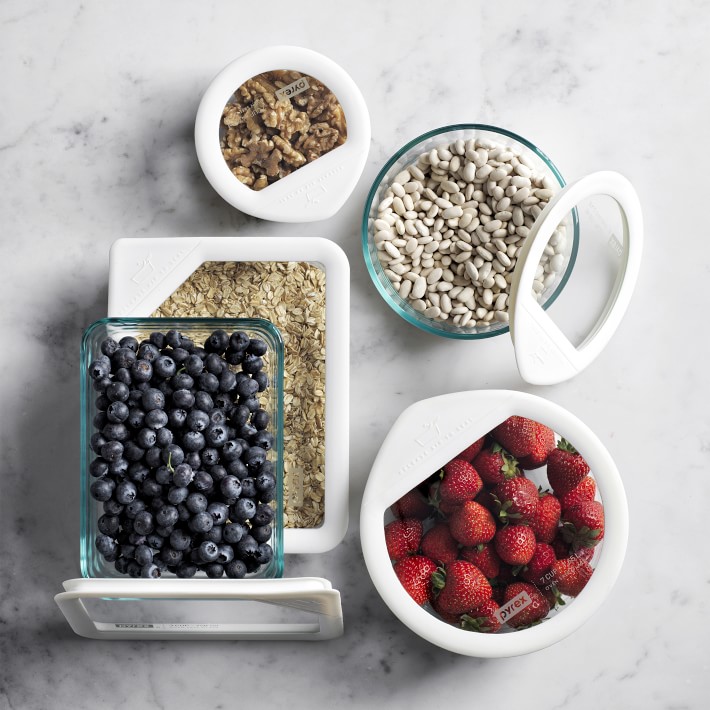
Price: $5 (single container) – $80
Pyrex is of course one of the most recognizable brands for plastic-free food storage and baking dishes. They offer lots of options, from rectangular meal-prep containers to variously sized circular containers and more.
If you go with Pyrex, you may want to consider the type of lid you want to get. Many Pyrex containers come with plastic lids, including their traditional seal-tight lids and the ‘Freshlock’ lids which snap shut for extra protection against leakage.
However, Pyrex also has completely plastic-free storage containers available now as well, which come with lids made from glass and silicone. They have a wooden lid collection as well.
The glass and silicone set is more expensive than the sets with plastic lids, so if you’re on more of a budget, the ones with plastic lids are still a much better option compared to storing your food in completely plastic containers! There is significantly less plastic in the container as a whole and the fact that your food most likely isn’t touching the lid very much.
I actually have a set of the completely plastic-free containers and I really like them. They don’t have a bunch of nooks & crannies, so they’re super easy to clean—either by hand or in the dishwasher. Plus, they look nice!
Pyrex has a ton of different options available on their website—including glass storage containers with fun characters like Star Wars and Harry Potter!
You can find Pyrex at:
Anchor Hocking

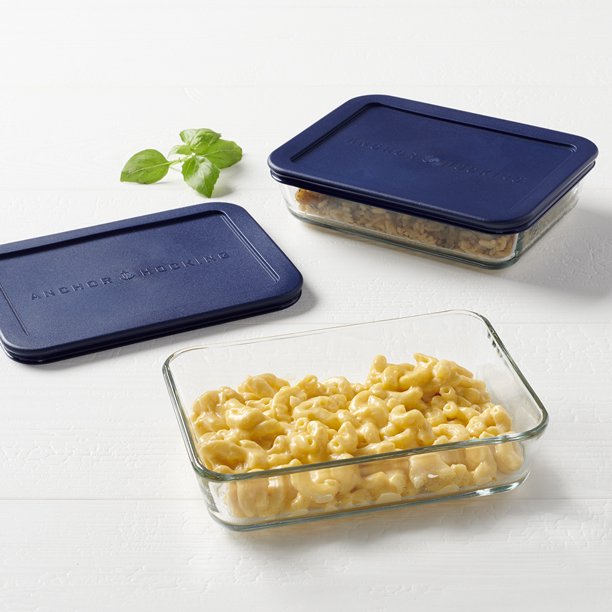
Price: $5.50 (single container) – $65 (set)
Anchor Hocking’s products are very similar to Pyrex’s, but typically come in at a more affordable price point. Like Pyrex, most of their lids are made using plastic, but they actually don’t have a completely plastic-free food storage option at this time.
Their Trueseal lids (the green ones pictured above) are made primarily of silicone, but they do have a circle of plastic at the top. These leak-proof lids are lighter weight and more durable than the Pyrex leak-proof lids that snap shut. However, some reviewers have complained about mold growth in the crevices, so you’ll definitely want to be careful about that and make sure to keep things clean.
Anchor Hocking is a company that’s been making glassware in the USA since 1905! As a side note, I recommend the book Glass House: The 1% Economy and the Shattering of the All-American Town, which is an interesting read about the life of the company. It’s a really insightful representation of how things like the rise of globalization and financial engineering have affected U.S. manufacturing (and the millions of people who have lost jobs because of it).
OXO

Price: $11 (single container) – $68 (set)
If you want glass containers that have locking-lids for leak-proof storage, you might want to look into a brand like OXO. The only problem with these types of containers is that the lids are almost always made with plastic (so you’ll want to take them off before putting them in the microwave or oven).
OXO’s glass containers come in various shapes and sizes, including circles and rectangles. They also have a set of bakeware with lids, which is convenient for things like brownies and casseroles! (They also have a lot of totally-plastic containers, so just make sure you check as you shop around so you don’t accidentally buy something you don’t want!)
In addition to their website, OXO containers are available in stores like Walmart and Williams-Sonoma. Similar brands include Kinetic Go Green (available at Target) and PrepNaturals (available at Walmart). As mentioned above, Pyrex has some locking-lid varieties as well.
Caraway (Ceramic-Coated Glass)

Price: $245 (set)
This trendy PFAS-free cookware brand now offers a food storage set as well. It comes with 14 pieces and is available in several different (really pretty!) colors.
The lids and the inner part of the containers are made out of glass, and then the bottom part of the containers are coated with ceramic. Sometimes you have to worry about heavy metals such as lead and cadmium in ceramic containers, but Caraway says these ones are free of not only heavy metals but also other toxins like PFAS and BPA.
This set is on the pricier side, but if you’re short on cabinet space, they do look good on a countertop!
Mason Jars

Price: $5.50 (single jar) – $74 (set)
Mason jars are a great affordable way to store leftovers, and you can find them pretty much anywhere, from Target to Walmart to Amazon to thrift stores!
Of course, they come in all kinds of different shapes and sizes so you can choose according to your preference. They also double as everyday drinking glasses.
You do have to worry about rust on the lids, but you can usually prevent most rust by hand-washing them instead of putting them in the dishwasher and then letting them air-dry all the way before putting them away. If you do get some rust, you can usually get it off relatively easily with some vinegar.

Similar to mason jars are preserving jars with wire bail and trigger closures, like these. You’ll just want to watch out for mold growth underneath the seal.
Recycled Glass Jars
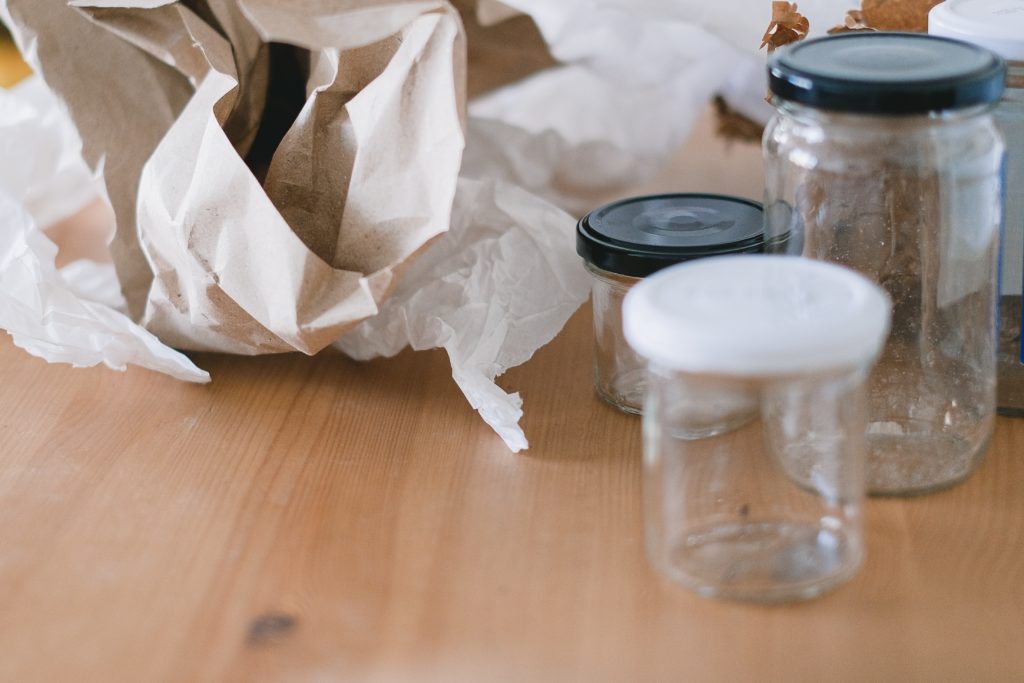
Another option is to keep the glass jars that your store-bought sauces, condiments, and jams come in and re-use those to store your leftovers. It’s the cheapest option, too!
2. Stainless Steel
Stainless steel containers are another great option. Unlike glass, it’s shatter-proof and school-safe. Here are the pros and cons and some of our recommended brands.
PROS
- Durable/shatterproof
- Kids can take them to school
- Safe in the dishwasher, oven, fridge, & freezer
- Easy to clean
- Can last a really long time if you take care of them
- Recyclable
CONS
- Not see-through
- Not microwave safe
- Sometimes stainless steel will leave a slight metallic taste in your food or drinks
U-Konserve
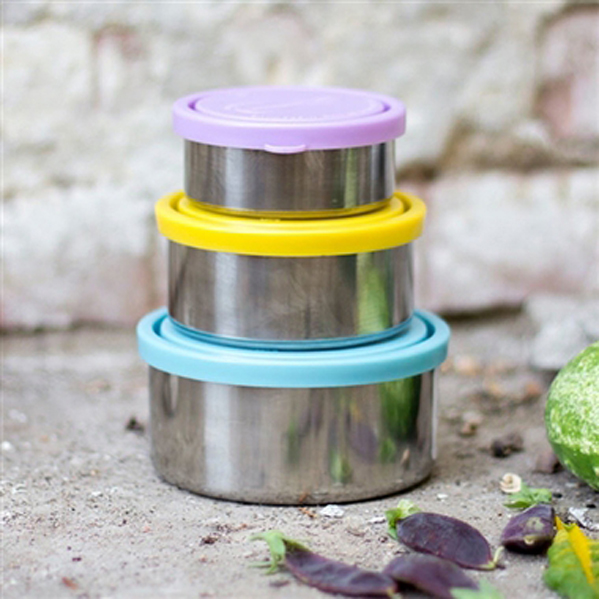
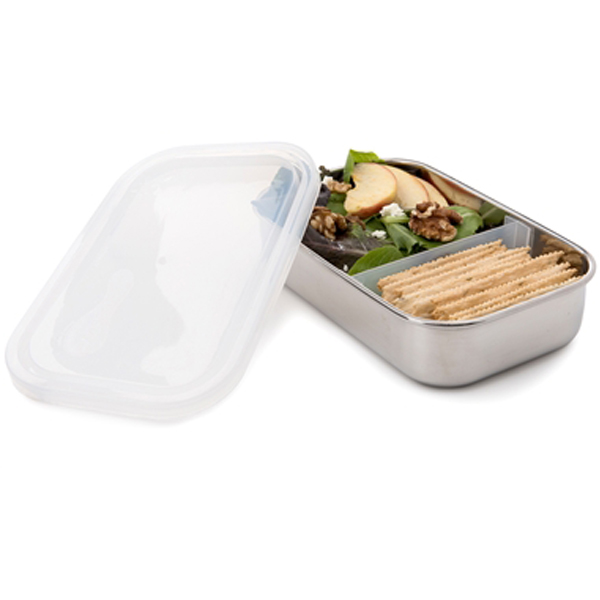
Price: $13-30 (each)
U-Konserve offers several different shapes and sizes of stainless steel plastic-free food storage containers, including nesting circular ones and rectangular ones that are great for school lunches. They also carry things like insulated food jars (great for things like soups), larger food storage canisters, and various kinds of eating utensils and straws made from bamboo and silicone.
These stainless steel containers are all tested by CPSIA-accredited independent labs to be free from things like BPA, phthalates, and lead. U-Konserve is also a B Corp and member of 1% for the Planet, which means they give 1% of profits to environmental non-profit organizations.
Note that some of the lids are made from plastic (the colored ones) while others are made out of silicone (the see-through ones).
ECOlunchbox


Price: $12 (single container) – $90 (large set)
ECOlunchbox is another great brand for stainless steel containers and lunchbox essentials. They also have nesting circular containers of various sizes, as well as modular bento boxes that snap close for a leak-proof seal. Their lids are made from either stainless steel or food-grade silicone, so everything is 100% plastic-free.
They also carry super cute washable lunch bags made from GOTS certified organic cotton. ECOlunchbox is a certified B Corp as well.
3. Silicone
High-quality silicone food storage containers are a great option as well. Although there is not a ton of research on silicone safety at this time, it appears to be mostly safe in terms of chemical leaching, with one exception.
There is some indication that at high heat, silicone may release endocrine disruptors, so I recommend keeping it out of the oven.
While shopping for silicone, you’ll want to be mindful of the fact that not all silicone is created equal. Lower-quality silicone products can have fillers and plasticizers added (to lower the cost), which means they are not completely plastic free and may leach toxic chemicals.
You’ll want to look for products made from 100% food-grade silicone. If you’re unsure, one quick check is to do the “pinch test.” Try pinching the silicone, and if it turns white, there’s a good chance it may have fillers in it. (This is not a fool-proof way of identifying the quality of the silicone; it’s just a little trick that can help.)
It’s also worth noting that silicone does not biodegrade, and it’s difficult to recycle. So if you’re worried about end-of-life, you may want to reconsider silicone.
PROS:
- Very lightweight & flexible
- Good for kids
- Good for travel
- Durable (especially the higher-quality silicone brands)
- Take up less space in cabinets and lunch boxes
- Safe in the fridge and freezer
CONS:
- Should be kept away from high heat (out of the oven)
- You have to be careful about buying silicone made with plastic fillers & dyes
- Food is more likely to get smashed
- It can sometimes stain (although not as easily as plastic)
- Not biodegradable or easily recyclable
Stasher

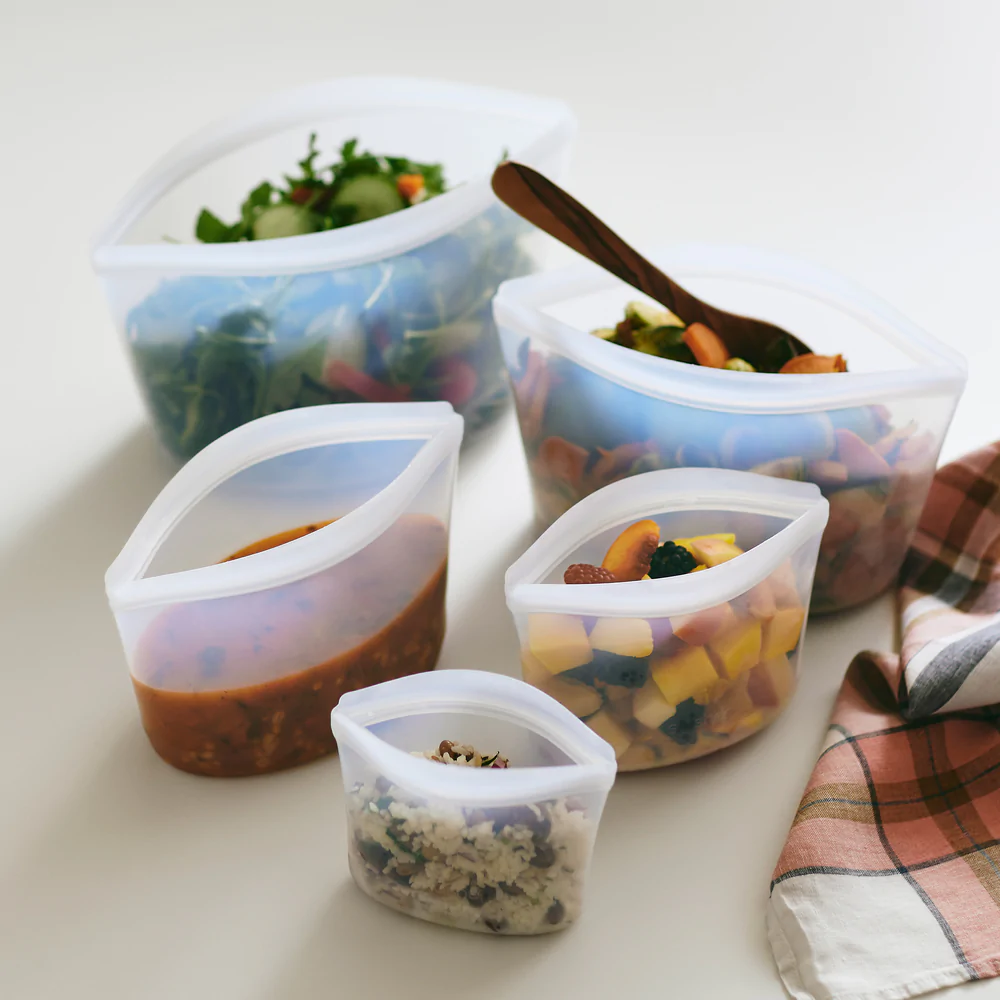
Price: $10 (single baggie) – $222 (large set)
Stasher bags have become pretty popular in recent years—and for good reason! They’re a great plastic-free alternative to Ziploc bags and they are an awesome durable and lightweight option. They have so many uses, including school lunches.
Stasher bags are made out of “platinum silicone,” which contains no added fillers, polymers, or by-products. They comply with both FDA and EU standards for food-grade silicone. (EU standards are more strict; they don’t allow any fillers in silicone that comes into contact with food.)
Stasher offers a really wide selection of sizes, shapes, and colors, so you’re pretty much guaranteed to find what you’re looking for in the baggie department. They even offer “bowls” now, which are basically just bags with wider bases.
Stasher says their bags are (top shelf) dishwasher, microwave, and oven safe. However, as mentioned above, I recommend keeping them out of the oven in order to prevent the potential leaching of endocrine disruptors. I personally hand-wash mine insead of putting them in the dishwasher.
Also, be mindful of the cracks and crevices in the silicone bags as well. Be careful not to leave food in the bags for too long, and make sure the bags dry completely before you put them away in order to prevent mold growth.
Frego

Price: $22 (each)
Frego combines the benefits of both glass and silicone. Frego containers start with a glass box and then add an FDA-approved silicone cover in order to prevent the glass from breaking. The air-tight, leak-proof lid is also made from silicone.
Frego doesn’t offer as many options as some of the other brands in terms of sizes and shapes, but they carry 2- and 4-cup square containers that come in several different colors.
Ello


Price: $10 – $45 (set)
Ello is another brand that combines silicone with other plastic-free materials such as glass and stainless steel. They carry many different shapes, sizes, and colors of food storage containers that combine glass, stainless steel, silicone, wood, and plastic. And, of course, they’re known for their cute non-toxic water bottles, travel mugs, and silicone straws!
I have a set of these and I really like them. With the silicone wrapped around them, they definitely feel less fragile than my all-glass Pyrex ones when I’m using and washing them. One downside is that I do have to remove the silicone sleeve every once in a while and wash underneath it. The space between the glass and the silicone just gets a little filmy-looking after a while.
Note that not all of Ello’s products are plastic-free, so just make sure to check the details before buying.
4. Beeswax Wraps
PROS
- Compostable / biodegradable
- Lightweight
- Can be all-natural/organic
- Can be used for a variety of purposes
CONS
- Not air-tight, leak-proof, or spill-proof (might not be the best option for kids, depending on what you’re putting in it)
- Can’t be used for liquid-y things


Price: $6 (single wrap) – $100 (large pack)
For a plastic-free alternative to conventional plastic cling wrap, beeswax wraps are a great zero-waste & eco-friendly option.
High-quality beeswax wraps are made out of organic cotton fabric and then covered in beeswax, which maintains freshness and allows you to wash and reuse the wrap.
You can use them to wrap up sandwiches or fruit or place them over bowls or other containers instead of using saran wrap.
Bee’s Wrap is perhaps the most well-known brand for beeswax wraps, but there are a lot of brands making them these days! You can find plenty of great small businesses on Etsy and you can also find beeswax wraps at big box stores like Target and Walmart. You can find them in lots of different sizes and fun designs.
5. Veggie-Saver Bags
PROS
- Washable
- Durable; lasts for years
- Made out of organic cotton
CONS
- Not suitable for all types of leftovers (best for produce)

Price: $23
Another great option for storing produce is crisper bags! These help keep your food fresh for longer, which can help reduce food waste and save money.
Vejibag is the brand I like best, although there are a couple of other brands making similar products, like Veggie Saver.
Vejibag is made out of USDA organic cotton that’s grown, milled, and sewn at worker-owned cooperatives in the United States. Instead of trapping air inside a plastic container, Vejibag creates a breathable environment that helps your produce last about two weeks longer… So it’s not only a great plastic-free option, but it saves food waste and money, too.
Vejibags are machine washable and come in three different sizes.
Other Materials to Consider for Non-Toxic Food Storage
Wood & Bamboo
You might notice that some of the brands above (like Pyrex) offer glass storage containers with wood or bamboo lids. These are good plastic-free options that are lighter-weight and less breakable than glass.
Just make sure to pay attention that any cracks that might form in the wood or bamboo over time—mold and bacteria love to grow there. (Some types of wood are more prone to mold than others.)
Hand-washing your wooden lids and/or re-applying a safe oil (like this one) every few months can help extend their life and prevent cracking.
Water
Some produce can be stored without any containers whatsoever! For things like apples, potatoes, celery, carrots, and avocados, cutting them up and putting them in water can keep your food fresh and make your produce last longer. You can also put the stems of things like kale and herbs in a glass of water (the way you’d put flowers in a vase) to make them last longer as well.
For produce that’s not cut up yet (apples, avocados, onions, etc.), you can skip those thin plastic produce bags at the grocery and go without storage altogether. These foods already have a natural protective layer on them and really don’t need to be kept in a container.
Ceramic
Although you’re not likely to store everyday leftovers in ceramic, you might want to use countertop ceramic food storage containers like those from Le Creuset for things like cookies or coffee beans.
The main concern when it comes to ceramic is heavy metal contamination. Things like lead and cadmium are very toxic, even at small doses, especially for children, so it’s important to be aware of.
If you are going to use ceramic food storage containers, make sure they are new (vintage ceramics are much more likely to contain high amounts of lead and other metals) and food-safe. Watch out for Prop 65 labels, and be especially careful about imported ceramics. Brightly colored ceramic is more likely to contain lead.
Best Practices If Using Plastic Food Containers
If you haven’t been able to swap out your plastic food storage containers yet, there are still some things you can do to at least reduce your toxicant exposure:
- Keep plastics (of all kinds) out of the microwave, the hot car, etc. Hand wash instead of putting them in the dishwasher. (Heat increasing leaching.)
- Try not to use plastic storage containers that are etched, cracked, or otherwise starting to break down. These are also going to leach more toxicants.
- Try to keep foods that are acidic, oily, high-fat, or hot away from plastic when possible.
- Do not re-use plastics that were meant to be single-use.
- Know which types of plastics are safer. In general, resin codes #2, #4, and #5 are the safest kinds of plastic. (You’ll be able to find the resin code somewhere on the product, usually accompanied by the triangle recycling symbol.)
What Should You Do With Your Old Plastic Food Storage Containers?
If you have a bunch of plastic containers that you don’t want to use for leftovers anymore, but you also don’t want to just chuck in the trash and send to the landfills—I totally get it.
In my opinion, it’s better to use your plastic for other things other than food storage. Here are some ideas for what to do with your old plastic containers:
- Use them to organize and store things like:
- art/craft supplies
- makeup
- receipts
- toiletries
- hardware (nails, screws, etc.)
- wires, cords, chargers, headphones
- office supplies
- jewelry
- junk drawer stuff!
- Use them as planters. You won’t want to use them for edibles like herbs or veggies, but you can poke some holes in the bottom and plant pollinator-friendly flowers or houseplants!
Can you recycle Tupperware?
Whether or not your old plastic containers can be recycled depends on the type of plastic they’re actually made of, as well as what the recycling capabilities in your area are. Look for the plastic resin code number on the container—usually #1 and #2 are the easiest to recycle (especially if they are clear and clean).
Final Thoughts on Plastic-Free & Non-Toxic Food Storage Containers
Ditching the plastic food containers and storing your food in non-toxic containers is an easy and relatively low-cost way to reduce exposure to toxicants like phthalates and bisphenols—while keeping your food fresh!
The next time you go to pack your lunch or throw some leftovers in the fridge, skip the endocrine disrupting materials and choose glass containers or silicone baggies instead!





I wonder about the use of colors in the storage boxes, etc. In your other reports, dyes or colors or? are no-nos.
Thanks in advance!
Hi Barbara,
Good question! This could be another reason to go with plain glass when possible. For silicone, you could go with undyed if you wanted to be safe (Stasher has plenty of undyed options). But overall, I’m personally not too worried about the dyes used in these types of products… Stasher, for example, uses food-safe dyes/colorants that pass European requirements and don’t come with a Prop65 warning (which means they’re azo-free).